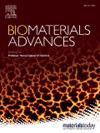Minimum reporting requirements for platelet-rich plasma in biomaterial research
IF 6
2区 医学
Q2 MATERIALS SCIENCE, BIOMATERIALS
Materials Science & Engineering C-Materials for Biological Applications
Pub Date : 2025-04-09
DOI:10.1016/j.bioadv.2025.214314
引用次数: 0
Abstract
Platelet-rich plasma (PRP) is gaining significant attention in regenerative medicine, offering an abundance of growth factors and bioactive molecules that promote tissue repair and healing. In biomaterial research, PRP is often incorporated into scaffolds to enhance their bioactivity, facilitating cell attachment, proliferation, and differentiation for improved tissue regeneration. However, inconsistencies in outcomes and variability across studies hinder its clinical translation. These challenges are primarily attributed to the lack of standardized reporting criteria for PRP characterization, which limits reproducibility and cross-study comparisons. Accurate characterization of PRP is essential for understanding its biological activity and therapeutic potential. Key parameters include platelet, white blood cell, and red blood cell concentrations. Recent classification systems, such as those proposed by the ISTH Subcommittee on Platelet Physiology, emphasize the importance of these parameters in categorizing PRP types. Establishing minimal reporting requirements helps address variability in PRP studies, ensuring consistency and transparency in the methodology and results. By adopting these standards as mandatory reporting requirements, researchers can reduce variability, enhance the credibility of their findings, and facilitate the development of standardized protocols for PRP-based therapies.
生物材料研究中富血小板血浆的最低报告要求
富血小板血浆(PRP)在再生医学中越来越受到重视,它提供了丰富的生长因子和生物活性分子,促进组织修复和愈合。在生物材料研究中,PRP常被加入到支架中,以增强其生物活性,促进细胞附着、增殖和分化,从而改善组织再生。然而,研究结果的不一致性和可变性阻碍了其临床转化。这些挑战主要归因于缺乏PRP表征的标准化报告标准,这限制了可重复性和交叉研究比较。准确表征PRP对了解其生物活性和治疗潜力至关重要。关键参数包括血小板、白细胞和红细胞浓度。最近的分类系统,如ISTH血小板生理学小组委员会提出的分类系统,强调了这些参数对PRP类型分类的重要性。建立最低限度的报告要求有助于解决PRP研究中的可变性,确保方法和结果的一致性和透明度。通过采用这些标准作为强制性报告要求,研究人员可以减少可变性,提高其研究结果的可信度,并促进基于prp的治疗的标准化方案的发展。
本文章由计算机程序翻译,如有差异,请以英文原文为准。
求助全文
约1分钟内获得全文
求助全文
来源期刊
CiteScore
17.80
自引率
0.00%
发文量
501
审稿时长
27 days
期刊介绍:
Biomaterials Advances, previously known as Materials Science and Engineering: C-Materials for Biological Applications (P-ISSN: 0928-4931, E-ISSN: 1873-0191). Includes topics at the interface of the biomedical sciences and materials engineering. These topics include:
• Bioinspired and biomimetic materials for medical applications
• Materials of biological origin for medical applications
• Materials for "active" medical applications
• Self-assembling and self-healing materials for medical applications
• "Smart" (i.e., stimulus-response) materials for medical applications
• Ceramic, metallic, polymeric, and composite materials for medical applications
• Materials for in vivo sensing
• Materials for in vivo imaging
• Materials for delivery of pharmacologic agents and vaccines
• Novel approaches for characterizing and modeling materials for medical applications
Manuscripts on biological topics without a materials science component, or manuscripts on materials science without biological applications, will not be considered for publication in Materials Science and Engineering C. New submissions are first assessed for language, scope and originality (plagiarism check) and can be desk rejected before review if they need English language improvements, are out of scope or present excessive duplication with published sources.
Biomaterials Advances sits within Elsevier''s biomaterials science portfolio alongside Biomaterials, Materials Today Bio and Biomaterials and Biosystems. As part of the broader Materials Today family, Biomaterials Advances offers authors rigorous peer review, rapid decisions, and high visibility. We look forward to receiving your submissions!

 求助内容:
求助内容: 应助结果提醒方式:
应助结果提醒方式:


